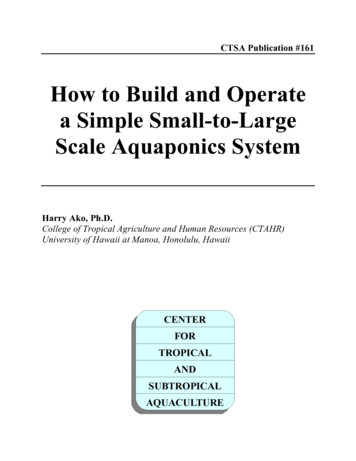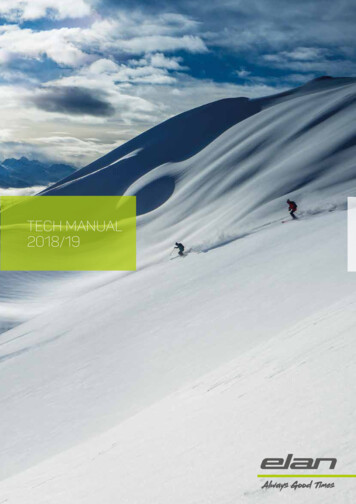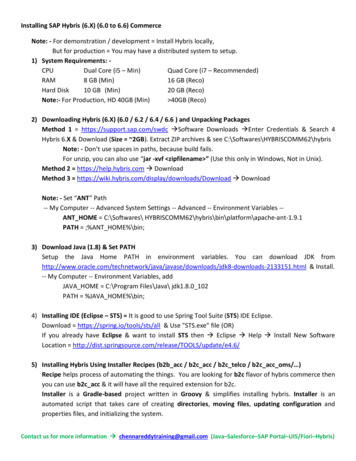
Transcription
CTSA Publication #161How to Build and Operatea Simple Small-to-LargeScale Aquaponics SystemHarry Ako, Ph.D.College of Tropical Agriculture and Human Resources (CTAHR)University of Hawaii at Manoa, Honolulu, Hawaii
INTRODUCTIONAquaponics is the symbiotic production of vegetables and fish. Fish eat food and releasemetabolites into the water derived from the food. These metabolites are further metabolized bybacteria, and the products of this metabolism are pumped into a plant grow bed where they aretaken up by plants for nourishment. Aquaponics is suitable for environments with limited landand water because it produces about three to six times the vegetables (Resh 2004) and uses about1% of the freshwater used by traditional aquaculture (Rakocy 1989).Sneed et al. (1975) published the first description of an aquaponic system, which divertedaquaculture effluent through plant growing troughs. The concept was that the nutrients inaquaculture effluent could be put to good use to nourish and grow plants; meanwhile, potentiallypolluted fish water would be cleaned up before being released into the environment. Plantsshowed signs of nutrient deficiencies within a month, likely due to a couple of factors. Inhindsight, fertilizer nitrate nitrogen was 150 times lower than it is today. Furthermore, theculture water was exposed to sunlight, which allowed microalgae to grow and further reducedthe available nutrients. At around the same time, Dr. John Todd and Nancy Jack Todd ledsimilar work at the New Alchemy Institute, which resulted in a natural wastewater treatmentsystem marketed as a ‘living machine.’In 1978, Lewis et al. sought to address the dilute nutrient issue. They worked with thefirst recirculating aquaponic system, which was developed to operate with a high fish stockingdensity. While the idea was good, nitrate concentrations were too low at 6–10 mg/L, andproducers were required to add a complete nutrient solution to support tomato growth. As ageneral rule of thumb, nitrate levels should be around 46 mg/L. The low nitrate levels coupledwith high amounts of fish feed suggested that massive denitrification, or conversion of fertilizernitrate to nitrogen gas, was occurring and the nitrogen was being released into the atmosphere.In 1986, Zweig developed a simple and productive aquaponic system by matching thefeeding rate and biomass of the fish to the estimated nitrogen needs of the plants. Iron deficiencywas addressed by replacing 20% of the fish feed with rabbit feed. While this work was animportant step in the development of the technology, it went largely unnoticed.In 1985, Nair et al. (1985) developed a recirculating aquaponics system at the Universityof the Virgin Islands (UVI). Similar to the system of Lewis et al. (1978), it used complexcomponents and engineering that kept operating costs high at 3.18/kg of tilapia produced (1985prices). Tomato plants grew poorly despite an estimate that nitrogen production by fish shouldhave exceeded plant requirements by ten fold. Unfortunately, the understanding and preventionof denitrification was not well understood at the time. Salts that inhibit the growth of some plantspecies (Jones 2005) accumulated in the system. Iron averaged 0.1 mg/L, which is less than theminimum of 1–2 mg/L suggested for hydroponic plant culture (Jones 2005). Researchers MarkMcMurtry, Douglas Nelson, and Paul Nelson of North Carolina State University also developeda recirculating aquaponics system. They placed their plants in a gravel bed creating an in situbiofilter.
In 1993, Rakocy and Hargreaves reviewed aquaponics research and concluded thatestimates of nutrient uptake and a deeper understanding of culture water nutrient dynamics are anecessity in the development of criteria for designing aquaponics systems. Rakocy et al. (1993)attempted to track plant nutrient uptake in the UVI aquaponic systems operated with and withoutplants. Unfortunately, nutrients accumulated at equal rates in all systems and uptake by plantswas not demonstrated. A follow up experiment was conducted to determine the optimal fishnumber-to-plant-growing-area ratio. In hindsight, we now believe that the nutrients produced byfish should have exceeded plant needs in all treatments. Lettuce head weights were about thesame in all treatments irrespective of the range of fish stocking densities tested. The plantsgrown in the aquaponics system were smaller than those produced hydroponically (172–248 g;Kratky 2005), suggesting malnutrition. After refinement, the system produced lettuce heads of acomparable size (181–344 g; Rakocy et al. 1997). A number of years later, it was demonstratedthat the UVI system could be operated productively and continuously (Rakocy et al. 2004). Thefinal system consisted of four fish tanks, six plant troughs, a clarifier tank, screen filter tanks,degassing tanks, a sump tank, a base addition tank, a water pump, two air blowers, and over 200air stones. A technically trained staff was used to operate it. Rakocy was effectively the firstperson to develop a fully-functional aquaponics system and thus, is often referred to as the‘grandfather of aquaponics.’Generally, plants were grown in water on floating polystyrene sheets called rafts (Rakocy1989). Rafts require substantial aeration of the water to provide oxygen to plant roots and tosupport nitrification. Kratky (2005) used a system in which plant roots were held out of the waterand exposed to moist air; this could be called a nutrient film technique. Lennard and Leonard(2006) tested three kinds of systems, some of which have been subsequently used by others.They tested the following designs: gravel systems flooded with water, systems using the nutrientfilm technique in which plant roots were exposed to air and roots were bathed with a thin layer offish water, and raft systems. They found that the gravel systems flooded with water were thebest. Ako (2013) tested trickling water under gravel, gravel ebb and flow, rafts with air gaps, andstandard rafts. He found the first two to be best, but the former to be more maintenance free.It has been more than 20 years since Rakocy modified the technology, yet there are noknown successful commercial systems based on his design. One purpose of the work highlightedin this publication is to remedy this. However, we can now see in hindsight that aquaponics iseconomically challenging. It cannot tolerate low prices for vegetables, low system biologicalperformance, high capital expenses, or high operational expenses and remain profitable(Tokunaga et al.) In some Pacific Islands, vegetables are very expensive because they must beimported by airplane. Aquaponics has the advantage of producing vegetables that taste uniquelygood and are grown organically, as fish and pesticides are incompatible. In particular, ourobjectives were to develop systems that require less capital investment and to develop operatinginstructions that are based on basic biology and chemistry. Systems should have clear chemicalspecifications, and remedies for chemical imbalances should be provided.
BUILDING A SYSTEMThe present systems were modeled after Kratky’s (2005) extremely inexpensivehydroponics systems. Kratky used simple wooden boxes. Grow-bed units are shallow woodenboxes with a piece of plywood for a bottom (3/4” x 4’ x 8’), two 2” x 4” side pieces (8’ long),and two 2” x 4’ end pieces (4’ long) (Fig. 1). These grow-beds are quick and inexpensive toconstruct (about 84 each). Each bed produces 48 heads of leafy greens, such as lettuce; somevegetables, such as mustard cabbage (kai choy or Brassica juncea), require 5 weeks to grow to apound.Figure 1. Grow trayTo construct the box, screws are placed through the bottom once every approx. 41 cm (16”).2x8 stainless steel screws (5.1 cm long and 0.44 cm in diameter) or 3x10 stainless steel screws(5.1 cm long and 0.52 cm in diameter) are used, as shown in Fig 2. A photo of the bottom andsides of a tray ready for attachment (Fig. 3.) Boxes are constructed upside down.Figure 2. Steel screws used to attachthe walls of the grow-beds.Figure 3. Bottom of tray ready to bescrewed to sides.
The plastic liner is then attached (Fig. 4). Growers can find their own plastic; one availablesource is www.reefindustries.com.Figure 4. Attaching liner to the tray.In practice, many trays are attached to each other. Figure 5 shows a typical setup for commercialproduction. Usually 8 pieces of plywood form a raceway. The number 8 is used because rolls ofplastic are usually about 100 feet long. The greatest challenge is to ensure that all of the trays arelevel. They need to be level or fish water will puddle somewhere in the tray. Raceways aresupported by double hollow tiles (as seen in Figure 5).Figure 5. Typical raceways consisting of 8 pieces ofplywood connected end to end.Trays at the first commercial farm built with the Ako and Baker (2009) system design are about5 years old and show no signs of wearing. This is because the wood never gets wet.Tray covers. Plants sit in 2” (5.1 cm) net pots supported by the white polystyrene covers, orrafts, shown below (Fig. 6). Grow-beds are filled with enough water to reach the bottom of thenet pots, and lettuce plant roots grow down into the water to take up nutrients. It is noted thatthis leaves about 5 cm (or 2 inches) of air space between the raft and the surface of the water,approximating well-aerated tilled soil.
Figure 6. Young lettuce plant in a net pot on apolystyrene sheet.Recently we have found superior and more consistent performance growing plants in about 5 cmof volcanic cinder flushed with about 1.5 cm of fish water. We call this a trickle (i.e., tricklefilter) gravel system. Ebb and flow systems using bell siphons are just as good but we prefertrickle gravel systems because worms can live and eat fecal material from fish in these systems.The raceway below is an ebb and flow raceway (Fig. 7).Figure 7. Gravel filled raceway with plants growingin the gravel.Water is pumped from the fishtanks into the raceway, and returns to the fish tank via a standpipeand bulkhead.As the project evolved, nursery sheets were developed. These are similar to the polystyrene traycovers, but are drilled much more densely to support the growth of 98 small plants per tray cover(when the plants are very small). The polystyrene sheets rest on the wall of the tray, and three 4”
plastic flower pots may be placed in each tray to prevent sheets from sagging. Most farmers useseed-starting trays, which are closely-spaced sheets of cups that may be filled with potting soil.However, potting soil adds organic matter to the system. The seed-starting trays are kept moistfor about three weeks, after which time plants are large enough to plant in growout trays. Mostplants require about three more weeks before they are harvested and sold.Most farmers automate seeding. Putting one seed in each cup is very tedious and timeconsuming. Aquaponics is very labor intensive (Tokunaga et al. 2014) and automation iswelcomed.Lettuce plants require partial shading to grow well in tropical climates such as Hawaii or thePacific Islands (Wolff and Coltman 1990). At UHM, lettuce was found to grow well under 50%shade cover from a shadecloth. Figure 5 shows raceways with shadecloth.Initial work has been done with the red sails variety of leaf lettuce. It was found to grow well inthis system. Other varieties of lettuce such as Manoa lettuce or romaine lettuce were also foundto grow well; kai choi and bok choy (Brassica juncea) and basil (Ocimum basilicum) have alsodone well. Other farmers grow beets, cucumber, tomatoes, blueberries, strawberries, andwatercress.Mosquitoes are a frequent problem in raft aquaponics systems, as stagnant water can accumulatein grow beds. They may be easily controlled by stocking about 3 male guppies in each grow trayto eat mosquito larvae. Stocking of multiple genders may lead to breeding, and if populationsget too high the guppies will eat the plant roots.The following ratios work well for aquaponics. We suggest using the nutrient-flux hypothesis,which matches the feed fed (42 g/day of Silver Cup trout chow with 42% protein) to the amountof metabolites that must be remediated and detoxified by either a gravel grow bed or a 4.2 gallon(16 L) submerged biofilter in a 321 L tank (Fig. 8). To make this biofilter, a cylinder measuring10” by 13” (25 x 32 cm) is made from extruded plastic netting and filled with PVC biofiltermedia. A 25 W air pump and three 6-inch airstones are optimal to aerate such a tank. The tankshould be filled with about 200 L of water. The initial stocking density of fish should be 2.5 kg.The fish tanks must be shaded to prevent microalgae from growing.Figure 8. Plastic fish tanks with biofilter.A 15 cm ruler is shown for size reference.
Fish feeding should start out slowly and increase over two weeks to the level of about 6.5tablespoons of feed (42 g) per day. This is a rough estimate, as the fish determine how muchthey want to eat. The slow increase should allow for the growth of bacteria, which are recruitedfrom the environment to detoxify the water. Fish are fed twice daily; once in the mid-morningwhen water temperatures begin to rise and once in the evening. The best way to determinefeeding amounts is to feed fish the predetermined amount, and then ten minutes after feeding,count the number of particles remaining. If 5-10% of the feed remains after 10 minutes, the mealsize should be kept the same; if more than 10% is left over, the meal size should be decreased; ifless than 5% is left over, the meal size should be increased. Iron chelate (1/8 teaspoon) must beadded weekly to each raceway.Water quality should be tested twice a week so that toxicants such as ammonia and nitrite couldbe monitored to ensure they are declining as biofilter bacteria grow. We use a YSI 55 DO meterto test our water; it is expensive but DO is very important in aquaponics. Dissolved oxygen mustbe kept above 5 mg/L in the fish tanks for the fish to feed vigorously, and above 2 mg/Lanywhere in the system to prevent denitrification from occurring. We use a portable pH meter(Pinpoint; American Marine Inc, Ridgefield, CT, USA) in the field and generally aim to keep thepH above 6.0. If it falls below, we add potassium carbonate to the water at a level of 1 teaspoonfor every 80 teaspoons of feed fed to remediate pH. We have found that feeding slows or stops ifpH is too low. Total ammonia and nitrite may be measured using inexpensive API or Tetra kits,though Hach and LaMotte kits are more accurate and should be considered the gold standard.Total ammonia may be converted to unionized ammonia by using the Henderson-Hasselbachequation:pH pKa log (unionized ammonia/total ammonia)pH is measured and pKa is 9.25 for ammonia. Total ammonia or TAN (total ammonia nitrogen)is measured using the kit. Once the unionized ammonia value is calculated, it must be kept inmind that 1.46 mg/L is lethal for tilapia (Evans et al. 2006). Nitrite values must be multiplied by0.31 to get nitrite-nitrogen. A level of about 16 mg/L is lethal for tilapia (Lewis et al. 1986).Nitrate-nitrogen may be determined using Salifert kits, though Lamotte kits (LaMotte Company,Chestertown, MD, USA) are more accurate but unstable. Good levels in the fish tank are about47 mg/L but when the water is flowed, it becomes diluted; we have had successful aquaponicstrials with nitrate-nitrogen at 15 mg/L. Bioremediating bacteria and nutrient levels shouldstabilize after about a month. Levels of toxins should be low.If you experience any issues, use the checklist on the following page to ensureyour system is functioning properly.
AQUAPONICS ‘BEST MANAGEMENT PRACTICES’CHECKLIST1. Are your plants in the sun? Plants grow by photosynthesis, which requires lightof at least 30,000 Lux. We use a light meter on farms where plants are not in directsunlight, and don’t bother with light determinations where plants are in the sun.2. Are your fish tanks shaded? If not, algae can grow and use up the nutrients.3. Are your fish feeding to satiety? We normally ask the farmer how much food thefish eat, and then conduct our 10 min satiety test. In all cases we have found that thefish were being underfed. This leads to fertilizer nitrate levels that are too low.4. What is your nitrate nitrogen level? When these are low ( 15 mg/L) there isprobably some denitrification occurring; when this occurs, we use the DO meter tofind low DO spots, which must be corrected.5. Have you considered switching to a trickle gravel system? Our research hasfound these are more efficient systems that are easier to maintain.6. How is your organic certification going? Organically certified vegetables sellfor between 3 and 4 per pound. Prices are the largest determinant of profitabilityaccording to Tokunaga et al (2014).7. Are your fish dying? If so, unionized ammonia or nitrite may be too high in thesystem, and biofiltration needs to be boosted.
Literature citedAko, H., Research into Technologies of Commercial Aquaponics . Presentation made at a widely sponsoredworkshop at Windward Community College, May 25, 2013.Ako, H. and A. Baker. 2009. Small-scale lettuce production with hydroponics or aquaponics. College of TropicalAgriculture and Human Resources, Publication No. SA-2. University of Hawaii, Manoa, Hawaii, USA.Evans, J.J., D. J. Pasnik, G.C. Brill, and P.H. Klesius. 2006. Un-ionized ammonia exposure in Nile Tilapia;Toxicity, Stress Response, and Susceptibility to Streptococcus agalactiae. North American Journal ofAquaculture 68:23-33.Kratky, B. A. 2005. Growing lettuce in non-aerated, non-circulated hydroponic systems. Journal of VegetableScience 11:35-42.Lennard, W.A. and B.V. Leonard, 2006. A comparisonofthreedifferenthydroponicsub- que)inanAquaponictestsystem.Aquacult Int 14:539–550Lewis Jr., W.M. and D.P. Morris. 1986. Toxicity of Nitrite to Fish: A review. Transactions of the AmericanFisheries Society 115:183-195.Nair, A., J. E. Rakocy, and J. A. Hargreaves. 1985. Water quality characteristics of a closed recirculating systemfor tilapia culture and tomato hydroponics. Pages 223-254 in R. Day and T. L. Richards, editors.Proceedings of the 2nd International Conference on Warm Water Aquaculture: Finfish. Brigham YoungUniversity, Laie, Hawaii, USA.Rakocy, J. E. 1989. Vegetable hydroponics and fish culture - a productive interface. World Aquaculture 20:42-47.Rakocy, J. E., D. S. Bailey, C. Shultz, and W.M. Cole. 1997. Evaluation of a commercial-scale aquaponic unit forthe production of tilapia and lettuce. Pages 603-613 in K. Fitzsimmons, editor. Tilapia aquaculture:Proceedings from the 4th International Symposium on Tilapia in Aquaculture. Northeast RegoinalAgricultural Engineering Service, Ithaca, New York.Rakocy, J. E. and J. A. Hargreaves. 1993. Integration of vegetable hydroponics with fish culture: a review. Pages112-136 in J.K. Wang, editor. Techniques of modern aquaculture. American Society of AgriculturalEngineers, St. Joseph, Missouri, USA.Rakocy, J. E., J. A. Hargreaves, and D. S. Bailey. 1993. Nutrient accumulation in a recirculating aquaculturesystem integrated with hydroponic vegetable production. Pages 148-158 in J. K. Wang, editor. Techniquesof modern aquaculture. American Society of Agricultural Engineers, St. Joseph, Missouri, USA.Resh, H. M. 2004. Hydroponic food production: A definitive guide for the advanced home gardener andcommercial hydroponic grower, sixth edition. New Concept Press, Inc., Mahwah, New Jersey, USA.Sneed, K., K. Allen, and J. E. Ellis. 1975. Fish farming and hydroponics. Aquaculture and the Fish Farmer 2:1120.Tokunaga, K., C. Tamaru, H. Ako, and P.S. Leung. 2014. Economics of Commercial Aquaponics in Hawaii. UnderReview at WAS.Wolff, X. Y. and R. R. Coltman. 1990. Productivity of eight leafy vegetable crops grown under shade in Hawaii.Journal of the American Society of Horticultural Science 155:182-188.Zweig, R. D. 1986. An integrated fish culture hydroponic vegetable production system. Aquaculture Magazine12:34-40
CTSA Publication #161 How to Build and Operate a Simple Small-to-Large Scale Aquaponics System Harry Ako, Ph.D. Co










